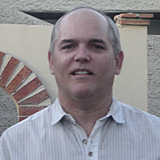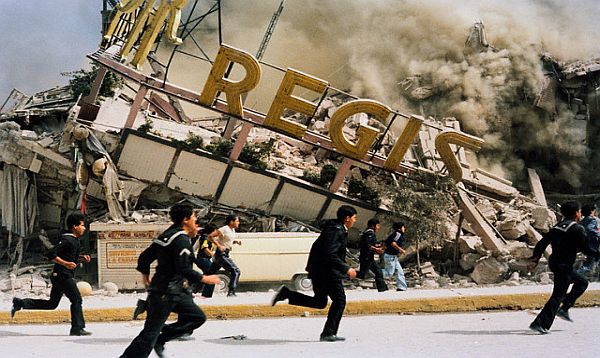Mexico City - September 19th was the thirtieth anniversary of the Mexico City Earthquake of 1985. The 1985 earthquake was devastating, its death toll is still under dispute, and it even had an effect on Mexico's political development.
The earthquake hit at 7:19 on the morning of September 19th, 1985. It had a 8.0 on the Moment Magnitude Scale (MMS) which measures energy released, and a IX on the Mercalli Intensity scale, which measures the effects. (The famous Richter Scale is no longer used by seismologists, though you may still hear the term in the media.) It was followed by an aftershock the next day.
There were around 5,000 bodies recovered from debris. A baseball field had to be used as a morgue, conserving bodies temporarily with ice so they could be identified. Others went missing and were never accounted for. The most common estimates put the death toll at around 10,000, though others claim as many as 30,000 to 45,000 deaths.
One thing that saved a lot of people is the earthquake hit in the morning when many people were not yet in office buildings and schools that were badly damaged.
The earthquake caused 412 buildings in the Mexico City metroplex to collapse, with 3,124 other buildings sustaining serious damage. Buildings in the 6 to 15 stories in height were the hardest hit. Buildings of from one to five stories in height were not damaged as badly, nor were those of 16 stories or higher. The hardest-hit buildings were those constructed from 1957 to 1976, because that's when Mexico City buildings were getting higher.
The 44-story Torre Latinoamericana had almost no damage. It had been constructed from 1946 to 1956, with 200 piles which extended down over 100 feet into stable earth. (Mexico City having been constructed on a lake bed, the surface level is unstable.) The Torre Latinoamericana had been designed by Mexican civil engineers, brothers Leonardo Zeevaert and Adolfo Zeevaert. During the 1985 earthquake, Adolfo Zeevaert was actually inside the tower, on the 25th floor, safely watching other buildings collapse.
There were political repercussions of the earthquake. During this time, Mexico was still a one-party state, ruled by the PRI (Partido Revolucionario Institucional) which controlled the media (and this was the pre-internet era). Incredibly, President Miguel de la Madrid ordered a blackout on reports of the earthquake, not publicly addressing it for 39 hours afterwards. The government's mishandling of the earthquake and its aftermath further eroded confidence in the PRI and encouraged the growth of non-PRI organizations.
In their book Opening Mexico: The Making of a Democracy, Julia Preston and Samuel Dillon discuss the role of the earthquake in Mexico's political transition. Here is what I wrote in a 2004 review of that book:
The 1985 earthquakes in Mexico City demonstrated the PRI's utter helplessness in dealing with crisis. Preston and Dillon deserve credit for casting light on the government's response and on how the political situation exacerbated the national tragedy. Approximately half of the buildings that collapsed in 1985 had been constructed by the Mexican government. (In contrast, centuries-old Spanish colonial structures were barely affected.) At first, Mexican president Miguel de la Madrid refused foreign help. Then the government attempted to bulldoze the ruins even before searching for survivors! A newly activated citizen movement delayed the bulldozing until the rubble could be searched. Some survivors were found, including eight newborn babies in a maternity ward, who would have perished in the rubble under the bulldozers. The tasteless banality of the PRI system was also displayed on this occasion. Following the earthquakes, the authorities of a government housing complex put up a mural boasting that, in this housing facility, there were "ONLY 472 DEAD." (Mexico Comes of Age Allan Wall, Chronicles Magazine, Dec. 2004)
A brief ceremony was held in Mexico City's Zocalo Plaza on the morning of September 19th, 2015. At 7:19 am, Mexican president Enrique Peņa Nieto hoisted the flag in Mexico City's Zocalo plaza to half-mast, in homage to those who perished in the 1985 earthquake thirty years ago.
Several hours later, a massive drill was held in Mexico City and other cities in the country, to practice for future possible earthquakes.
Living with natural disasters is part of life and their dangers cannot be eliminated. But the more people are educated on how to deal with them, the more prepared they are to some extent. It can save lives in the long run. Allan Wall is an American citizen who moved back to the U.S. after living and teaching English in Mexico for a decade and a half. Today, he continues to write articles about various aspects of Mexico and Mexican society. Some of these articles are about Mexico's political scene, history and culture, tourism, and Mexican emigration as viewed from south of the border, which you can read on his website at AllanWall.info.
Allan Wall is an American citizen who moved back to the U.S. after living and teaching English in Mexico for a decade and a half. Today, he continues to write articles about various aspects of Mexico and Mexican society. Some of these articles are about Mexico's political scene, history and culture, tourism, and Mexican emigration as viewed from south of the border, which you can read on his website at AllanWall.info.


